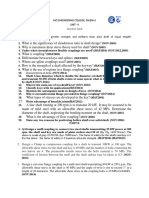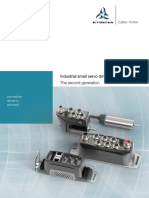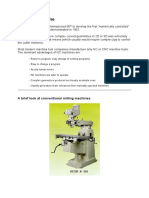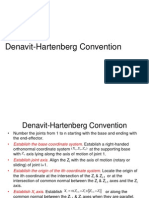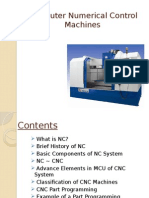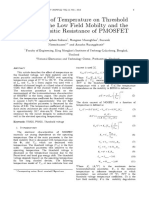Force and Torque Measurements
Force and Torque Measurements
Uploaded by
Arunabha DattaCopyright:
Available Formats
Force and Torque Measurements
Force and Torque Measurements
Uploaded by
Arunabha DattaOriginal Description:
Original Title
Copyright
Available Formats
Share this document
Did you find this document useful?
Is this content inappropriate?
Copyright:
Available Formats
Force and Torque Measurements
Force and Torque Measurements
Uploaded by
Arunabha DattaCopyright:
Available Formats
FORCE & TORQUE
MEASUREMENTS
Link type load cell
A simple uniaxial link-type load cell with strain
gages as the sensor is a very common load cell
configuration. The load P can be either a tensile
load or a compressive load.
The four strain gages are bonded to the link such
that two are in the axial direction and two are in
the transverse direction. The four gages are
wired into a Wheat stone bridge with the axial
gages in arms 1 and 3 and the transverse gages
in arms 2 and 4.
Link type load cell
Link type load cell
When the load P is applied to the link, axial and transverse
strains and develop in the link and are related to the load by
the expressions
Where,A is the cross-sectional area of the link.
E is the modulus of elasticity of the link material.
is Poissons ratio of the link material.
AE
vP
AE
P
t a
= = c c
Link type load cell
The output voltage Eo from the Wheatstone bridge
can be expressed in terms of the load P. If it is
assumed that the four strain gages on the link are
identical, then R1 = R2. Therefore,
Or
o o
i
CE E
E v K
AE
P =
+
=
) 1 (
2
AE
E v KP
E
i
o
2
) 1 ( +
=
Beam type load cell
Beam-type load cells are commonly
employed for measuring low-level loads
where the link-type load cell is not
effective.
A simple cantilever beam with two strain
gages on the top surface and two strain
gages on the bottom surface (all oriented
along the axis of the beam) serves as the
elastic member and sensor for this type of
load cell.
Beam type load cell
Beam type load cell
The load P produces a moment M = Px at the
gage location x that results in the following
strains:
Where b is the width of the cross section of the
beam
h is the height of the cross section of the beam
2 2
4 3 2 1
6 6
Ebh
Px
Ebh
M
= = = = = c c c c
Beam type load cell
The output voltage Eo from the Wheatstone
bridge, resulting from application of the load P, is
obtained by assuming the four strain gages on
the beam to be identical
or
2
6
Ebh
E KP
E
i x
o
=
o o
i
CE E
KxE
Ebh
P = =
6
2
Ring type load cell
Ring-type load cells incorporate a proving ring as
the elastic element. The ring element can be
designed to cover a very wide range of loads by
varying the diameter D (or radius R), the
thickness r, or the depth w of the ring.
Either strain gages or a linear variable-
differential transformer (LVDT) can be used as
the sensor.
Ring type load cell
Ring type load cell
If an LVDT is used to measure the diametric
compression or extension o of the ring, the
relationship between displacement o and load P is
given by the following approximate expression:
Equation (6.14) is approximate since the
reinforced areas at the top and bottom of the
ring that accommodate the loading attachments
have not been considered in its development.
3
3
79 . 1
Ewt
PR
= o
Torque Cell
Torque cells are transducers that convert
torque to an electrical signal.
The two types of torque cells in common usage
include those installed on fixed shafts and
those installed on rotating shafts. The latter
type is more difficult to utilize, since the
electrical signal must be transmitted from the
rotating shaft to a stationary assembly of
recording instruments.
The problem of signal transmission will be
considered after design concepts associated
with torque cells are discussed.
Torque Cell
Torque Cell
A circular shaft with four strain gages mounted
on two perpendicular 45-degree helixes is shown
in figure.
Gages 1 and 3, mounted on the right-had helix,
sense a positive strain, while gages 2 and 4,
mounted on the left-hand helix, sense a negative
strain. The two 45-degree helixes define the
principal stress and strain directions for a circular
shaft subjected to pure torsion.
Torque Cell
The shearing stress t in the circular shaft is
related to the applied torque T by the equation
Where D is the diameter of the shaft and J is the
polar moment of inertia of the circular cross
section
Since the normal stresses o
x
= o
y
=o
z
= 0 for a
circular shaft subjected to pure torsion
3
16
2
D
T
J
TD
xz
t
t = =
3
2 1
16
D
T
xz
t
t o o = = =
Torque Cell
Principal strain are obtained by using equations
and Hookes law for the plane state of stress.
Thus,
|
.
|
\
|
+
= =
|
.
|
\
|
+
= =
E
v
D
T
v
E
E
v
D
T
v
E
1 16
) (
1
1 16
) (
1
3
1 2 2
3
2 1 1
t
o o c
t
o o c
Torque Cell
The response of the strain gages is obtained from
the equations above as
If the gages are connected into a Wheatstone
bridge, as illustrated, the relationship between
output voltage E
o
and torque T is obtained as
K
E
v
D
T
R
R
R
R
R
R
R
R
|
.
|
\
|
+
=
A
=
A
=
A
=
A 1 16
3
4
4
3
3
2
2
1
1
t
i o
KE
E
v
D
T
E
|
.
|
\
|
+
=
1 16
3
t
Torque Cell
Or
Equation indicates that the torque T is linearly
proportional to the output voltage E
o
and that the
constant of proportionality or calibration constant
C is given by
o o
i
CE E
KE v
E D
T =
+
=
) 1 ( 16
3
t
i
KE v
E D
C
) 1 ( 16
3
+
=
t
Torque Cells-Data Transmission
Frequently, torque must be measured on a
rotating shaft, which necessitates signal
transmission between a Wheatstone bridge on
the rotating shaft and a stationary
instrumentation centre.
Signal transmission under these circumstances is
usually accomplished with either slip rings or
telemetry.
Slip Rings
The slip-ring assembly contains a series of
insulated rings mounted on a shaft and a
companion series of insulated brushes mounted
in a case.
High-speed bearings between the shaft and the
case permit the case to remain stationary while
the shaft rotates with the torque cell.
A commercial slip-ring assembly is shown in the
figure
Slip Rings
The major problem associated with slip-ring usage is
noise (generated by contact resistance variations
between the rings and brushes).
The contact resistance variations can be kept within
acceptable limits if the rings are fabricated from
monel metal (a copper-nickel alloy), if the brushes are
fabricated from a silver-graphite mixture, and if the
ring-brush contact pressure is maintained between 50
and 100 psi.
Rotational speed limits of slip-ring assemblies are
determined by the concentricity that can be
maintained between the shaft and the case and by the
quality of the bearings. Slip-ring units with speed
ratings of 6000 rpm are available.
Slip Rings
Signal Transmission with Telemetry
In many applications, the end of the shaft is not
accessible for mounting of the slip-ring unit and
telemetry must be used to transmit the signal from
the rotating shaft to the recording instrument.
The output from the Wheatstone bridge is used to
modulate a radio signal. The strain gages, bridge,
power supply, and radio transmitter are mounted
on the rotating shaft, while the receiver and
recorder are located at a stationary instrumentation
centre.
In most applications, the distance over which the
signal must be transmitted is only a few feet;
therefore, low-power transmitters, which do not
need to be licensed, can be used.
Telemetry system
You might also like
- X04-Industrial Robot Programming - Lab ManualNo ratings yetX04-Industrial Robot Programming - Lab Manual9 pages
- Experimental Comparison of Trajectory Tracking Algorithms For Nonholonomic Mobile RobotsNo ratings yetExperimental Comparison of Trajectory Tracking Algorithms For Nonholonomic Mobile Robots6 pages
- Joints Types: Revolute Joint 1DOF Prismatic Joint Joint 1DOFNo ratings yetJoints Types: Revolute Joint 1DOF Prismatic Joint Joint 1DOF33 pages
- Automotive Chassis Components Design Notes100% (1)Automotive Chassis Components Design Notes41 pages
- Lecture 4 - Mechanical Advantage, Transmission AngleNo ratings yetLecture 4 - Mechanical Advantage, Transmission Angle3 pages
- Cad Cam Principles And Applications 3Rd Edn 3rd Edition P. N. Rao download pdf100% (2)Cad Cam Principles And Applications 3Rd Edn 3rd Edition P. N. Rao download pdf81 pages
- Fire Fighter Robot With Night Vision CameraNo ratings yetFire Fighter Robot With Night Vision Camera7 pages
- Important Questions and Answers - Robot Drive Systems and End Effectors PDFNo ratings yetImportant Questions and Answers - Robot Drive Systems and End Effectors PDF5 pages
- Design of Machine Members-I: Lecture NotesNo ratings yetDesign of Machine Members-I: Lecture Notes74 pages
- Sudharsan Engineering College: UNIT I Fundamentals of RobotsNo ratings yetSudharsan Engineering College: UNIT I Fundamentals of Robots7 pages
- EJERCICIOS MECANISMOS - Javier Fuentes CNo ratings yetEJERCICIOS MECANISMOS - Javier Fuentes C10 pages
- Robot Arm Without Using Robot Language and Its Application To Machining ProcessNo ratings yetRobot Arm Without Using Robot Language and Its Application To Machining Process5 pages
- B Tech - 6 Sem (CBGS) Course Code: ME 602 Subject Name: Machine Component & Design Important Questions Unit - 1No ratings yetB Tech - 6 Sem (CBGS) Course Code: ME 602 Subject Name: Machine Component & Design Important Questions Unit - 16 pages
- 5 Machinability and Machining EconomicsNo ratings yet5 Machinability and Machining Economics48 pages
- Project On Hydraulic Telescopic Transmission JackNo ratings yetProject On Hydraulic Telescopic Transmission Jack69 pages
- Dynamics and Control of Robotic Manipulators with Contact and FrictionFrom EverandDynamics and Control of Robotic Manipulators with Contact and FrictionNo ratings yet
- Measurement Systems: Application and Design by Ernest O. DoebelinNo ratings yetMeasurement Systems: Application and Design by Ernest O. Doebelin20 pages
- Ramgarh Engineering College: 6 Semester, Electrical Engineering Advanced Control Systems (EE603)No ratings yetRamgarh Engineering College: 6 Semester, Electrical Engineering Advanced Control Systems (EE603)1 page
- Ramgarh Engineering College: Advanced Control Systems (EE603)No ratings yetRamgarh Engineering College: Advanced Control Systems (EE603)15 pages
- Apl Apollo Tubes Limited Unit-Iii: Test Certificate For Rhs and BLKNo ratings yetApl Apollo Tubes Limited Unit-Iii: Test Certificate For Rhs and BLK1 page
- The Effect of Temperature On Threshold Voltage, The Low Field Mobilty and The Series Parasitic Resistance of PMOSFETNo ratings yetThe Effect of Temperature On Threshold Voltage, The Low Field Mobilty and The Series Parasitic Resistance of PMOSFET8 pages
- Experiment 1-Pure Bending in Beam-EMD4M3B1-Group G1 PDFNo ratings yetExperiment 1-Pure Bending in Beam-EMD4M3B1-Group G1 PDF74 pages
- ROB at 263+538 - Steel Composite Girder-R2No ratings yetROB at 263+538 - Steel Composite Girder-R237 pages
- Mechanical Properties of Poly (Ether-Etherketone)No ratings yetMechanical Properties of Poly (Ether-Etherketone)9 pages
- Previous Years GATE MCQ's On Work, Heat and Power - Engineering TutorialsNo ratings yetPrevious Years GATE MCQ's On Work, Heat and Power - Engineering Tutorials9 pages
- Chapter 2 - Design of Beam For Flexure and Shear100% (2)Chapter 2 - Design of Beam For Flexure and Shear43 pages
- Not Not: Answer. (1pt Each) Answer. (1pt Each)No ratings yetNot Not: Answer. (1pt Each) Answer. (1pt Each)2 pages
- Materials For High Temperature High Pressure Applications andNo ratings yetMaterials For High Temperature High Pressure Applications and28 pages
- Thermal Cycling Analysis of Bga Solder Joint ReliabilityNo ratings yetThermal Cycling Analysis of Bga Solder Joint Reliability12 pages
- Koga (2021) - Influence of Layer Thickness On Tensile Deformation and Fracture in The FerriteNo ratings yetKoga (2021) - Influence of Layer Thickness On Tensile Deformation and Fracture in The Ferrite9 pages
- Chapter 4 Waves and Optics - Wave Properties and LightNo ratings yetChapter 4 Waves and Optics - Wave Properties and Light2 pages
- Experimental Comparison of Trajectory Tracking Algorithms For Nonholonomic Mobile RobotsExperimental Comparison of Trajectory Tracking Algorithms For Nonholonomic Mobile Robots
- Joints Types: Revolute Joint 1DOF Prismatic Joint Joint 1DOFJoints Types: Revolute Joint 1DOF Prismatic Joint Joint 1DOF
- Lecture 4 - Mechanical Advantage, Transmission AngleLecture 4 - Mechanical Advantage, Transmission Angle
- Cad Cam Principles And Applications 3Rd Edn 3rd Edition P. N. Rao download pdfCad Cam Principles And Applications 3Rd Edn 3rd Edition P. N. Rao download pdf
- Important Questions and Answers - Robot Drive Systems and End Effectors PDFImportant Questions and Answers - Robot Drive Systems and End Effectors PDF
- Sudharsan Engineering College: UNIT I Fundamentals of RobotsSudharsan Engineering College: UNIT I Fundamentals of Robots
- Robot Arm Without Using Robot Language and Its Application To Machining ProcessRobot Arm Without Using Robot Language and Its Application To Machining Process
- B Tech - 6 Sem (CBGS) Course Code: ME 602 Subject Name: Machine Component & Design Important Questions Unit - 1B Tech - 6 Sem (CBGS) Course Code: ME 602 Subject Name: Machine Component & Design Important Questions Unit - 1
- Dynamics and Control of Robotic Manipulators with Contact and FrictionFrom EverandDynamics and Control of Robotic Manipulators with Contact and Friction
- Computer Aided Design of Electrical MachinesFrom EverandComputer Aided Design of Electrical Machines
- Measurement Systems: Application and Design by Ernest O. DoebelinMeasurement Systems: Application and Design by Ernest O. Doebelin
- Ramgarh Engineering College: 6 Semester, Electrical Engineering Advanced Control Systems (EE603)Ramgarh Engineering College: 6 Semester, Electrical Engineering Advanced Control Systems (EE603)
- Ramgarh Engineering College: Advanced Control Systems (EE603)Ramgarh Engineering College: Advanced Control Systems (EE603)
- Apl Apollo Tubes Limited Unit-Iii: Test Certificate For Rhs and BLKApl Apollo Tubes Limited Unit-Iii: Test Certificate For Rhs and BLK
- The Effect of Temperature On Threshold Voltage, The Low Field Mobilty and The Series Parasitic Resistance of PMOSFETThe Effect of Temperature On Threshold Voltage, The Low Field Mobilty and The Series Parasitic Resistance of PMOSFET
- Experiment 1-Pure Bending in Beam-EMD4M3B1-Group G1 PDFExperiment 1-Pure Bending in Beam-EMD4M3B1-Group G1 PDF
- Previous Years GATE MCQ's On Work, Heat and Power - Engineering TutorialsPrevious Years GATE MCQ's On Work, Heat and Power - Engineering Tutorials
- Materials For High Temperature High Pressure Applications andMaterials For High Temperature High Pressure Applications and
- Thermal Cycling Analysis of Bga Solder Joint ReliabilityThermal Cycling Analysis of Bga Solder Joint Reliability
- Koga (2021) - Influence of Layer Thickness On Tensile Deformation and Fracture in The FerriteKoga (2021) - Influence of Layer Thickness On Tensile Deformation and Fracture in The Ferrite
- Chapter 4 Waves and Optics - Wave Properties and LightChapter 4 Waves and Optics - Wave Properties and Light




















